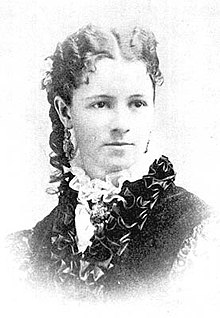Loading AI tools
American botanist and landscape architect From Wikipedia, the free encyclopedia
Katherine Olivia Sessions (November 8, 1857 – March 24, 1940) was an American botanist, horticulturalist, and landscape architect closely associated with San Diego, California. She is known as the "Mother of Balboa Park".[2]
Kate Sessions | |
|---|---|
 | |
| Born | Katherine Olivia Sessions November 8, 1857 San Francisco, California |
| Died | March 24, 1940 (aged 82) San Diego, California |
| Resting place | Mount Hope Cemetery, San Diego |
| Nationality | American |
| Occupation(s) | Horticulturalist, landscape architect |
| Known for | "Mother of Balboa Park"; introduced trees and plants to San Diego |
| Sessions Nursery Site Marker | |
|---|---|
| Location | Corner of Garnet Ave and Pico Street, San Diego, California |
| Coordinates | 32.805°N 117.223°W |
| Designated | April 28, 1961 |
| Reference no. | 764 [1] |
Sessions was born in San Francisco, California, and educated in Oakland.[2] At the age of six, she moved with her family to a farm next to Lake Merritt.[3] She attended the University of California, Berkeley in 1881, earning a degree in natural science.[3] While attending a San Francisco business school, at the request of a friend, she moved to San Diego in 1883 to work as an eighth grade teacher and vice principal at Russ School (now San Diego High School).[3][4] She worked at the school for over a year before leaving due to health problems.[3]
In San Diego, Sessions quickly developed an interest in the cultivation of plants. In 1885, she purchased a nursery; within a few years she was the owner of a flower shop as well as growing fields and nurseries in Coronado, Pacific Beach, and Mission Hills.[5][6] The Mission Hills Nursery, which she founded in 1910 and sold to her employees the Antonicelli brothers in 1926, is still in operation.[7]
In 1892, Sessions leased 30 acres (120,000 m2) of land in Balboa Park (then called City Park) from the City of San Diego to use as growing fields.[5] In return, she agreed to plant 100 trees a year in the mostly barren park, as well as 300 trees a year in other parts of San Diego.[2][6] This arrangement left the park with an array of cypress, pine, oak, pepper trees and eucalyptus grown in her gardens from seeds imported from around the world; virtually all of the older trees still seen in the park were planted by her. Among many other plant introductions, she is credited with importing and popularizing the jacaranda, now very familiar in the city. She also collected, propagated, and introduced many California native plants to the horticulture trade and into gardens.[5] In 1900, Sessions travelled to Baja California to find a palm tree not native in San Diego to be planted at the park.[5] She would also later take a seven-month trip through Europe where she collected multiple plant varieties that she eventually helped plant in the park.[5]
Together with Alfred D. Robinson, she co-founded the San Diego Floral Association in 1907; it is now the oldest garden club in Southern California. The garden club was influential in teaching San Diegans how to grow ornamental and edible plants, at a time when most San Diego landscaping consisted of dirt and sagebrush.[8]
Sessions collaborated with architect Hazel Wood Waterman on the garden design of a single-family home near Balboa Park built by San Diego socialite Alice Lee.
Sessions never married,[3] but maintained a close and lifelong friendship with Alice Eastwood and some people speculate that she may have been a member of the LGBTQ+ community.[9][10] Sessions died in San Diego on March 24, 1940, at the age of 82. She is interred in Mount Hope Cemetery in San Diego.
Kate's family followed her from the bay area to San Diego. She took on relatives as partners in business. Her father, Josiah, was a helper to her until his death in 1903 after her mother, Harriett, passed away in 1895. Frank, her only sibling, helped to start the first poinsettia nursery in Mission Hills. All three are buried next to her in Mt. Hope Cemetery. [11]
Despite 60 years of 12- and 14-hour work days, she gave herself only two vacations, and both included some horticultural work. Kate had no heirs except Milton, the son of her brother Frank. [11]
"Botanically speaking, I would call Miss Sessions a perennial, evergreen and everblooming."
—George Marston, at a 1935 garden dedication in her honor[5]
Sessions' work with plant introduction, as well as her extensive writing on the subject, won her international recognition. At the California Pacific International Exposition on September 22, 1935, the day was dedicated to Sessions, where she was named the "Mother of Balboa Park".[12] In 1939, she became the first woman to receive the prestigious Frank N. Meyer medal of the American Genetic Association.[13]

In the San Diego area, the Kate Sessions Elementary school in Pacific Beach bears her name, as does Kate Sessions Memorial Park on Mount Soledad, located less than a mile from the school and constructed only a few years later.[13]
A bronze statue of Sessions, dedicated in 1998, is situated in a prominent location in Balboa Park, in the southwest corner of Sefton Plaza, near the Sixth Avenue entrance to the park.[14]
In 2006, the Women's Museum of California inducted Sessions into the San Diego County Women's Hall of Fame, under the title of Trailblazer.[15][16]
A 2013 children's picture book, The Tree Lady: The True Story of How One Tree-Loving Woman Changed a City Forever, tells the story of Kate's life, education, and contribution to San Diego civic life.[17]
Seamless Wikipedia browsing. On steroids.
Every time you click a link to Wikipedia, Wiktionary or Wikiquote in your browser's search results, it will show the modern Wikiwand interface.
Wikiwand extension is a five stars, simple, with minimum permission required to keep your browsing private, safe and transparent.